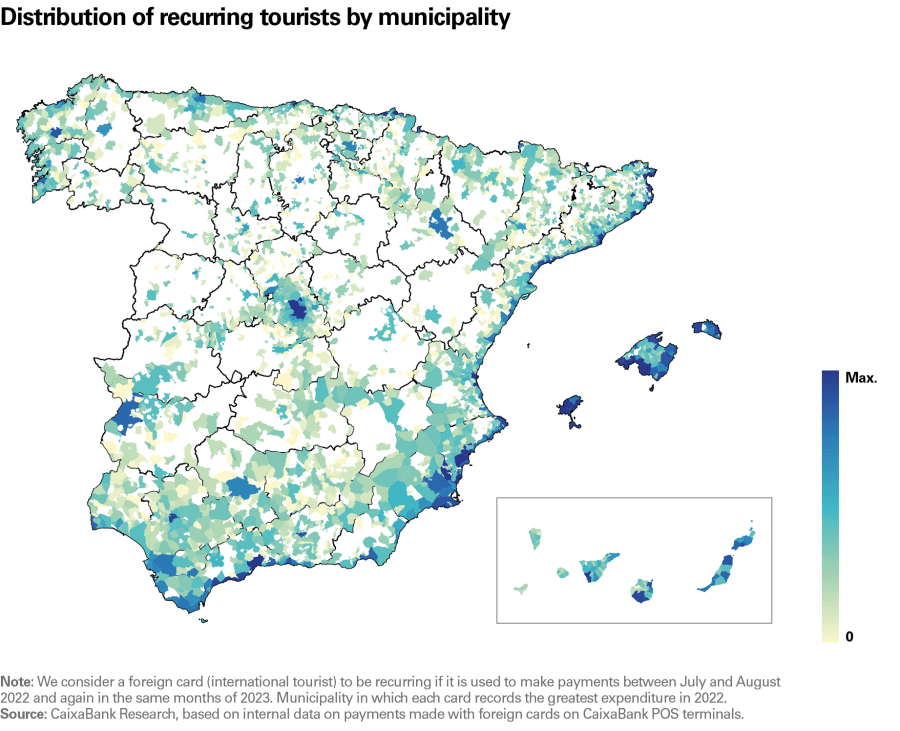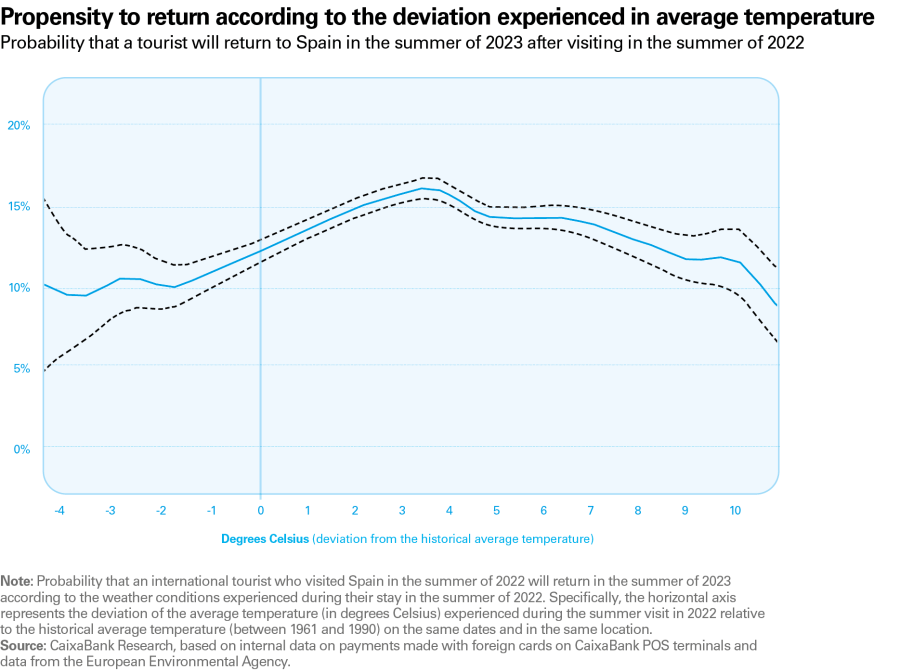Tourist loyalty and climate change
Repeating tourists are one of the keys to the success of Spain’s tourism sector, but climate change puts their loyalty at risk. In this article we present a highly innovative analysis using data on payments made with foreign cards on CaixaBank POS terminals, which allows us to identify the international tourists who visited Spain in the high season, both in 2022 and in 2023.

Repeating tourists are one of the keys to the success of Spain’s tourism sector, but climate change puts their loyalty at risk. In this article we present a highly innovative analysis using data on payments made with foreign cards on CaixaBank POS terminals, which allows us to identify the international tourists who visited Spain in the high season, both in 2022 and in 2023. We note that repeat tourists spend more per day and have longer stays, making them crucial for the tourism sector. However, we find that exposure to extreme heat waves reduces their propensity to return, especially among the British and Americans. Investing to adapt to climate change and promoting sustainable practices are essential in order to maintain the loyalty of recurring tourists and to ensure the continued success of tourism in Spain.
Approximately 14% of foreign cards that made payments on CaixaBank POS terminals in the summer of 2022 were also observed a year later. These are the tourists we refer to as «recurring» or «repeat» tourists, since they made repeat visits to Spain in the last two summers. These tourists are especially important because their daily spending is higher and their stays last longer, resulting in a substantially higher total expenditure per trip than among non-recurring tourists.8 In particular, tourists who visited in both the summer of 2022 and that of 2023 spent an average of 271.7 euros in the summer of 2022 during an average stay of 3.9 days. In contrast, non-repeat tourists spent 176 euros on average in the same summer and their average stay lasted 2.7 days. The daily tourist expenditure of recurring tourists recorded on CaixaBank POS terminals was 80.2 euros per day, compared to 76.3 euros per day for non-recurring tourists. As can be seen in the map on the following page, recurring tourists are concentrated in the archipelagos, the Mediterranean arc and some urban areas such as Madrid, Zaragoza, Seville, Cordoba, Badajoz and Santiago de Compostela.
It is important to note that these estimates represent lower bounds for tourism spending by foreigners, both in terms of expenditure and the duration of their stay. For instance, tourists also make purchases on POS terminals of other banks, a tourist may use several cards or change cards between one year and the next, and there may be days when they are in Spain but they do not make any payments on CaixaBank POS terminals9 . Therefore, these statistics should not be considered estimates of international tourists’ total expenditure or the full duration of their trips. However, they are useful for comparing repeat and non-repeat tourists, as the measurement biases are expected to be similar in both groups.
- 8. We consider a foreign card (international tourist) to be recurring if it is used to make payments between July and August 2022 and again in the same months of 2023. Aggregate expenditure data per card. The length of the stay of each card is defined based on the number of days that transactions with that card are observed for.
- 9. CaixaBank’s POS terminal payment data are highly representative (market share of around 30%).

A significant proportion of recurring tourists correspond to people who reside for a certain period in Spain, for instance because they have a second home or because they are living here temporarily for one reason or another, such as to study or to work (e.g. digital nomads). To analyse the specific behaviour of this group of foreigners, we have identified cards that have recorded expenditure in at least 30 days in at least three months. Based on this definition, 3% of foreign cards correspond to people who stay in Spain for a relatively long period, whom we will call «foreigners with a second home in Spain», although in reality this definition is likely to cover a much wider range of cases.
We note that the probability of a tourist returning in July and August in 2023, after visiting Spain in the same months of 2022, is fourfold in the case of foreigners with a second home in Spain. Specifically, the propensity to repeat is 51.3% for this group, compared to 12.8% for foreigners with more sporadic expenditure patterns (whom we consider to have «no second home»). This pattern is observed for all nationalities analysed.
If we focus on tourists who do not have a second home, we find that Germans, Swedes and the French are the ones with a greater propensity to repeat (around 15%). At the other end of the spectrum, US citizens without a second home return in just 6.8% of cases.
Climate change is a key challenge for tourism in Spain, as we warned in the previous Sector Report.10 Below, we analyse the changes in the propensity of tourists to return to Spain when they have been exposed to extreme heat waves. To do this, we collect an extremely detailed Copernicus database produced by the European Environmental Agency and match the climate information with geolocation data of foreign card transactions. Following the methodology of the World Meteorological Organization, we calculate the difference between the average temperature on the days in the summer of 2022 in the municipality where we observe the highest amount of spending on a given card and the average temperature between 1961 and 1990 on the same days. This calculation is performed for each card and municipality, so we have an approximation of the temperature deviation experienced by each tourist in the summer of 2022 with respect to the historical average.
Once equipped with this database of temperatures for each card, we estimate a non-parametric regression model that allows us to examine how the propensity of tourists to return to Spain in the summer of 2023 varies according to the temperatures they experienced in 2022 (relative to the historical average on the same days and in the same location).
In the following chart we observe that the propensity to repeat is approximately 13% when the temperature experienced is close to the historical average (a figure very similar to the average proportion observed in the data). The more noteworthy result is that when the average daily temperature experienced by tourists relative to the historical average exceeds 5ºC, then the propensity of tourists to repeat their visit is reduced. When the deviation relative to the historical average exceeds 8°C (extreme heat wave), the propensity to return is clearly lower than when the temperature experienced is similar to the historical average. We also find that, for temperatures below the 1961-1990 average, the propensity of international tourists to return decreases. This could be because relatively cold days are associated with rain or other adverse weather factors besides temperature, which can jeopardise tourists’ experience.
- 10. For an analysis of the impact of heat waves on tourism spending in Spain, see the article «The impact of climate change on tourism in Spain: analysis and outlook», published in the Tourism Sector Report of S1 2024.

To analyse the differences between nationalities in the face of heat waves, we focus on the temperature deviation threshold of 8°C experienced in the summer of 2022 relative to the historical average (4.4% of payments with foreign cards were made in municipalities that exceeded the average temperature between 1961 and 1990 by eight degrees or more).
Overall, the propensity of these tourists to return decreases from 14.0% to 12.1%, representing a 13.8% drop in the propensity to return. These falls are especially pronounced for tourists from the United Kingdom and United States, among whom the propensity to repeat after experiencing extreme heat waves falls from 11.2% to 7.4% and from 8.6% to 5.0%, respectively. These reductions represent decreases of 34.0% and 42.5%, respectively. At the other extreme, the tourists most resilient to extreme heat waves are the French and the Portuguese. They show more moderate declines in their propensity to repeat, sliding from 15.5% to 14.4% in the case of the French and from 15.5% to 14.1% among the Portuguese, representing falls of 7.4% and 8.7%, respectively.
The British and Americans are the least likely to make a repeat visit to Spain after experiencing extreme temperatures
The vulnerability of international tourism to heat waves underscores the sector’s high sensitivity to climate change. This underlines the importance of the tourism sector actively participating in the fight against climate change and implementing adaptation measures in order to mitigate its negative effects. One key factor for mitigating these effects is investment in infrastructure in order to guarantee tourists’ comfort in more extreme climate scenarios. This could include modernising hotels with efficient and sustainable air conditioning systems, as well as creating more shaded and green spaces in tourist areas. Taking action to address the challenge of climate change can also be an opportunity, given the growing preferences among tourists for sustainability.